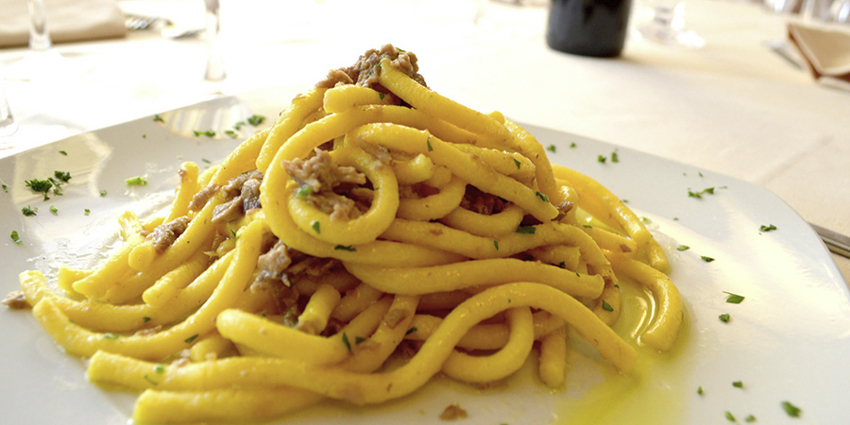
Traditional Cuisine of the Euganean Hills
A Journey through Authentic Taste and Heritage. The Euganean Hills: A Gastronomic Treasure in Veneto
Nestled in the green heart of southern Veneto, the Euganean Hills offer a charming landscape steeped in history, where nature and culinary culture blend in perfect harmony. This hilly area of volcanic origin is a true treasure trove of authentic flavors, deeply rooted in peasant traditions and recipes passed down through generations.
The traditional cuisine of the Euganean Hills is not just culinary heritage; it is a sensory experience that speaks of the land, its wholesome products, the rhythm of the seasons, and the craftsmanship of its people. It’s an ideal setting for hospitality businesses—such as farm stays, country inns, and guesthouses—to offer their guests a truly immersive cultural and gastronomic experience.
Local Ingredients: The Essence of Tradition
Characterful Wines
Wine plays a leading role at the Euganean table. Vineyards covering the slopes of the hills produce celebrated wines such as Serprino, Moscato Fior d’Arancio (available in dry, sparkling, and sweet versions), and full-bodied reds like Cabernet, Merlot, and Colli Euganei Rosso DOC. The volcanic soil contributes a distinct minerality and structure that make these wines unique.
Olive Oil, Honey, and Hilltop Fruit
The extra virgin olive oil produced in the Euganean Hills is known for its refined aromatic profile, featuring herbaceous notes and low acidity—ideal for enhancing simple dishes. Honey, particularly from chestnut, acacia, and wildflowers, is highly prized for its purity and richness. The jujube fruit, an ancient and rare delicacy, is symbolic of the region and used to make jams, syrups, and the traditional “brodo di giuggiole” (jujube liqueur).
Cured Meats and Cheeses
The area’s charcuterie tradition is diverse and abundant, including Veneto Berico-Euganeo PDO prosciutto, farm-cured salami, and handmade cotechino. Regional cheeses like Grana Padano, Montasio, and fresh mountain cheese are often served with honey or fruit mustards, adding complexity to the tasting experience.
Traditional Dishes of the Euganean Culinary Heritage
Appetizers
Starters often consist of local cured meats, crostini with liver pâté, aged cheeses with honey or jam, and homemade pickled vegetables. Wild herbs foraged in the hills—such as dandelion greens, hop shoots (bruscandoli), and poppy sprouts—feature in rustic frittatas and fresh seasonal salads.
First Courses
These dishes embody the region’s rural soul and seasonal rhythms:
- Risotto with bruscandoli (wild hop shoots)
- Bigoli with duck ragù, a thick handmade pasta with a slow-cooked sauce
- Potato gnocchi with goose ragù or woodland mushrooms
- Tagliatelle with white meat ragù, typically made from rabbit or guinea fowl
Main Courses
Meat is often the centerpiece of Euganean second courses:
- Roast duck, sometimes glazed with orange
- Padovana hen stewed in wine sauce
- Vicentina-style rabbit, slow-cooked with aromatic herbs
- Stuffed guinea fowl, often braised or roasted
Other traditional mains include mixed boiled meats, cotechino with cabbage, and baccalà with polenta, reflecting the richness of wintertime fare.
Side Dishes and Polenta
Polenta is a staple and pairs with almost every main dish. Served either soft or grilled, it complements mushrooms, grilled meats, and hearty sauces. Seasonal vegetables like grilled radicchio, sautéed wild greens, and sweet-and-sour pumpkin are common side options.
Traditional Desserts
Regional sweets include:
- Zaeti: rustic cornmeal cookies with raisins and lemon zest
- Galani: crispy fried carnival pastries
- Sugoli: a grape must pudding
- Fruit tarts made with jujube or fig preserves, often enjoyed with a glass of Fior d’Arancio dessert wine
Tradition and Hospitality: A Perfect Pairing
In the Euganean Hills, hospitality goes hand in hand with a celebration of local food culture. Agritourisms, countryside inns, and boutique hotels often offer guests much more than just a place to stay—they provide immersive experiences such as seasonal fruit picking, cooking classes, oil and wine tastings, and visits to artisanal producers.
By promoting traditional cuisine, hospitality businesses elevate their offerings, forging a genuine connection between guests and the territory.




